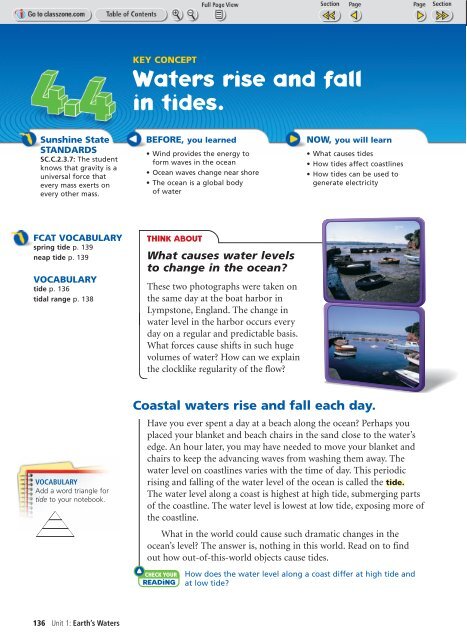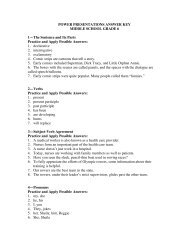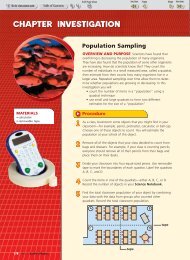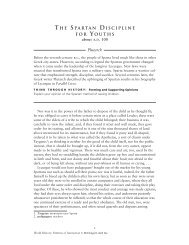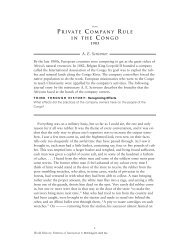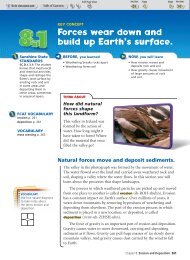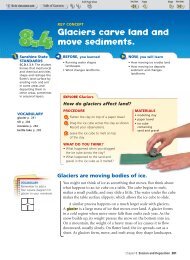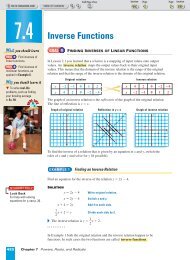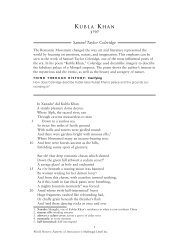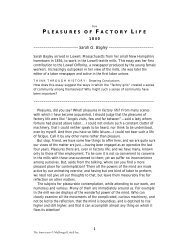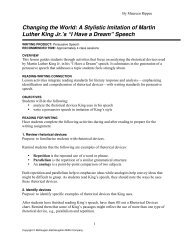Waters rise and fall in tides. - ClassZone
Waters rise and fall in tides. - ClassZone
Waters rise and fall in tides. - ClassZone
Create successful ePaper yourself
Turn your PDF publications into a flip-book with our unique Google optimized e-Paper software.
Sunsh<strong>in</strong>e State<br />
STANDARDS<br />
SC.C.2.3.7: The student<br />
knows that gravity is a<br />
universal force that<br />
every mass exerts on<br />
every other mass.<br />
FCAT VOCABULARY<br />
spr<strong>in</strong>g tide p. 139<br />
neap tide p. 139<br />
VOCABULARY<br />
tide p. 136<br />
tidal range p. 138<br />
VOCABULARY<br />
Add a word triangle for<br />
tide to your notebook.<br />
136 Unit 1: Earth’s <strong>Waters</strong><br />
KEY CONCEPT<br />
<strong>Waters</strong> <strong>rise</strong> <strong>and</strong> <strong>fall</strong><br />
<strong>in</strong> <strong>tides</strong>.<br />
BEFORE, you learned<br />
•W<strong>in</strong>d provides the energy to<br />
form waves <strong>in</strong> the ocean<br />
• Ocean waves change near shore<br />
• The ocean is a global body<br />
of water<br />
THINK ABOUT<br />
What causes water levels<br />
to change <strong>in</strong> the ocean?<br />
These two photographs were taken on<br />
the same day at the boat harbor <strong>in</strong><br />
Lympstone, Engl<strong>and</strong>. The change <strong>in</strong><br />
water level <strong>in</strong> the harbor occurs every<br />
day on a regular <strong>and</strong> predictable basis.<br />
What forces cause shifts <strong>in</strong> such huge<br />
volumes of water? How can we expla<strong>in</strong><br />
the clocklike regularity of the flow?<br />
NOW, you will learn<br />
• What causes <strong>tides</strong><br />
• How <strong>tides</strong> affect coastl<strong>in</strong>es<br />
• How <strong>tides</strong> can be used to<br />
generate electricity<br />
Coastal waters <strong>rise</strong> <strong>and</strong> <strong>fall</strong> each day.<br />
Have you ever spent a day at a beach along the ocean? Perhaps you<br />
placed your blanket <strong>and</strong> beach chairs <strong>in</strong> the s<strong>and</strong> close to the water’s<br />
edge. An hour later, you may have needed to move your blanket <strong>and</strong><br />
chairs to keep the advanc<strong>in</strong>g waves from wash<strong>in</strong>g them away. The<br />
water level on coastl<strong>in</strong>es varies with the time of day. This periodic<br />
ris<strong>in</strong>g <strong>and</strong> <strong>fall</strong><strong>in</strong>g of the water level of the ocean is called the<br />
tide.<br />
The water level along a coast is highest at high tide, submerg<strong>in</strong>g parts<br />
of the coastl<strong>in</strong>e. The water level is lowest at low tide, expos<strong>in</strong>g more of<br />
the coastl<strong>in</strong>e.<br />
What <strong>in</strong> the world could cause such dramatic changes <strong>in</strong> the<br />
ocean’s level? The answer is, noth<strong>in</strong>g <strong>in</strong> this world. Read on to f<strong>in</strong>d<br />
out how out-of-this-world objects cause <strong>tides</strong>.<br />
check your read<strong>in</strong>g How does the water level along a coast differ at high tide <strong>and</strong><br />
at low tide?
The gravity of the Moon <strong>and</strong> the Sun<br />
causes <strong>tides</strong>.<br />
Over 2000 years ago, people knew that the Moon <strong>and</strong> the tide were<br />
related. But 1700 years passed before the connection was expla<strong>in</strong>ed <strong>in</strong><br />
the terms of modern science. In 1687, Sir Isaac Newton developed his<br />
theories of gravity <strong>and</strong> l<strong>in</strong>ked the tide to the Moon’s gravitational pull.<br />
Gravity is a force of attraction between objects. Earth’s gravity pulls<br />
th<strong>in</strong>gs toward its center—<strong>in</strong>clud<strong>in</strong>g you.<br />
The gravity of the Sun <strong>and</strong> the gravity of the Moon also pull on<br />
objects on Earth. In response to the Moon’s gravitational pull, Earth’s<br />
water bulges on the side fac<strong>in</strong>g the Moon. The Moon’s gravity also<br />
pulls on Earth itself. Earth gets pulled toward the Moon, leav<strong>in</strong>g a<br />
second bulge of water on the side of Earth fac<strong>in</strong>g away from the<br />
Moon. The Sun’s gravity pulls too, but with less effect because the<br />
Sun is so far away.<br />
Daily Tides<br />
The diagram below shows the two bulges of ocean water: one on the<br />
side of Earth closest to the Moon, <strong>and</strong> the other on the opposite side<br />
of Earth. At these bulges, it is high tide. Between the two bulges are<br />
dips. At these dips, it is low tide. As Earth rotates, different parts of it<br />
pass through the bulges <strong>and</strong> the dips. As a result, most places experience<br />
two high <strong>tides</strong> <strong>and</strong> two low <strong>tides</strong> each day.<br />
Daily Tides<br />
Indirect High Tide The<br />
Moon’s gravity also pulls<br />
on Earth itself. Earth is<br />
pulled toward the Moon,<br />
leav<strong>in</strong>g beh<strong>in</strong>d a bulge of<br />
water on the side farthest<br />
from the Moon.<br />
low tide<br />
low tide<br />
Direct High Tide The Moon’s gravity pulls most strongly<br />
on the side of Earth fac<strong>in</strong>g the Moon. In response,<br />
Earth’s waters bulge on this side.<br />
force of gravity from Moon<br />
North Pole<br />
Not to scale.<br />
VISUALIZATION<br />
CLASSZONE.COM<br />
Watch daily <strong>tides</strong> <strong>in</strong><br />
action.<br />
Moon<br />
Which parts of Earth are experienc<strong>in</strong>g high <strong>tides</strong>,<br />
<strong>and</strong> which parts are experienc<strong>in</strong>g low <strong>tides</strong>?<br />
Chapter 4: Ocean Systems 137
A place farther east along<br />
a coastl<strong>in</strong>e experiences<br />
high <strong>and</strong> low <strong>tides</strong> earlier<br />
<strong>in</strong> the day, because it<br />
passes through the tidal<br />
bulge first. Times for<br />
high <strong>and</strong> low <strong>tides</strong><br />
change daily.<br />
The tim<strong>in</strong>g of high <strong>and</strong> low <strong>tides</strong> at one location<br />
on a coast may differ from the tim<strong>in</strong>g at other locations<br />
along that coast. As you can see on the map of the<br />
coastl<strong>in</strong>e of New Engl<strong>and</strong>, the <strong>tides</strong> occur later as you<br />
move west along the coastl<strong>in</strong>e. As Earth rotates, the<br />
easternmost po<strong>in</strong>ts on a coastl<strong>in</strong>e will pass through<br />
the tidal bulge before places farther west on the<br />
same coastl<strong>in</strong>e.<br />
The tim<strong>in</strong>g of high <strong>and</strong> low <strong>tides</strong> is not the only<br />
way that <strong>tides</strong> can differ along a coastl<strong>in</strong>e. Some places<br />
experience higher high <strong>tides</strong> <strong>and</strong> lower low <strong>tides</strong> than<br />
other places. The shape of the l<strong>and</strong> above <strong>and</strong> below<br />
the water affects tidal ranges. A tidal range is the difference <strong>in</strong> height<br />
between a high tide <strong>and</strong> the next low tide. The tidal range is greater <strong>in</strong><br />
a narrow bay than on a wide-open shore. For example, the narrow harbor<br />
of Lympstone, Engl<strong>and</strong>, shown <strong>in</strong> the photographs on page<br />
136, has a very large tidal range. A coastl<strong>in</strong>e with a steeply sloped ocean<br />
floor has a larger tidal range than a coastl<strong>in</strong>e with a gradually dropp<strong>in</strong>g<br />
floor. For example, the coasts of Texas <strong>and</strong> western Florida have very<br />
small tidal ranges because of the gradual slope of the ocean floor there.<br />
Check Your Read<strong>in</strong>g In what two ways does the shape of the l<strong>and</strong> affect the tidal<br />
range? What sentences tell you this?<br />
How does the Moon make <strong>tides</strong>?<br />
PROCEDURE<br />
1<br />
2<br />
3<br />
Tides<br />
Cut the Tides datasheet <strong>in</strong> two, along the dotted l<strong>in</strong>e. Cut out the map of<br />
Earth on the bottom half of the sheet.<br />
Use a paper fastener to connect the two pieces as shown <strong>in</strong> the photograph.<br />
Now you are ready to model the <strong>tides</strong>. Rotate Earth one full turn <strong>in</strong> the direction<br />
of the arrow. One full turn is equal to one day.<br />
WHAT DO YOU THINK?<br />
•How does the model demonstrate the Moon’s<br />
role <strong>in</strong> <strong>tides</strong>?<br />
•How many times does each place <strong>in</strong> the ocean<br />
experience high tide <strong>and</strong> low tide each day?<br />
CHALLENGE One full rotation of Earth takes<br />
place <strong>in</strong> a day, or 24 hours. About how much time<br />
passes between one high tide <strong>and</strong> the next high<br />
tide at any location on Earth?<br />
138 Unit 1: Earth’s <strong>Waters</strong><br />
Portl<strong>and</strong>, ME<br />
high tide: 9:36 P.M.<br />
low tide: 3:15 P.M.<br />
Boston, MA<br />
high tide: 9:41 P.M.<br />
low tide: 3:23 P.M.<br />
SKILL FOCUS<br />
Mak<strong>in</strong>g models<br />
MATERIALS<br />
•Tides datasheet<br />
• scissors<br />
• brass paper<br />
fastener<br />
TIME<br />
15 m<strong>in</strong>utes
Monthly Tides<br />
The Moon is the ma<strong>in</strong> cause of <strong>tides</strong>, but the Sun affects <strong>tides</strong> as<br />
well. The Moon takes about a month to move around Earth. Twice<br />
dur<strong>in</strong>g this month-long journey—at the new moon <strong>and</strong> the full<br />
moon—the Moon, the Sun, <strong>and</strong> Earth l<strong>in</strong>e up. The gravity of the Sun<br />
<strong>and</strong> the gravity of the Moon comb<strong>in</strong>e to pull Earth’s waters <strong>in</strong> the<br />
same directions. The result is an extra-high tidal bulge <strong>and</strong> an extralow<br />
tidal dip, called a spr<strong>in</strong>g tide.<br />
Dur<strong>in</strong>g first- <strong>and</strong> third-quarter moons, the Sun <strong>and</strong> the Moon are<br />
not l<strong>in</strong>ed up with Earth. The gravity of each pulls from a different<br />
direction. The result is a smaller tidal bulge <strong>and</strong> tidal dip, called a<br />
neap tide. Dur<strong>in</strong>g a neap tide, high <strong>and</strong> low <strong>tides</strong> are less extreme.<br />
Changes <strong>in</strong> the tim<strong>in</strong>g <strong>and</strong> the height of <strong>tides</strong> occur <strong>in</strong> a regular<br />
cycle. The tim<strong>in</strong>g of <strong>tides</strong> may be important to people who live near<br />
a coast or use coasts for fish<strong>in</strong>g or boat<strong>in</strong>g. In many coastal communities,<br />
tide tables pr<strong>in</strong>ted <strong>in</strong> newspapers give the exact times <strong>and</strong> heights<br />
of the <strong>tides</strong>.<br />
Monthly Tides<br />
Spr<strong>in</strong>g Tide<br />
Sun<br />
Neap Tide<br />
Moon<br />
Earth<br />
Not to scale.<br />
How are Earth, the Moon, <strong>and</strong> the Sun positioned dur<strong>in</strong>g<br />
spr<strong>in</strong>g <strong>tides</strong>? How are they positioned dur<strong>in</strong>g neap <strong>tides</strong>?<br />
RESOURCE CENTER<br />
CLASSZONE.COM<br />
F<strong>in</strong>d out more about<br />
ocean <strong>tides</strong>.<br />
read<strong>in</strong>g tip<br />
Spr<strong>in</strong>g <strong>tides</strong> occur twice<br />
a month all year long, not<br />
just <strong>in</strong> spr<strong>in</strong>g. This use of<br />
the word spr<strong>in</strong>g is related<br />
to its mean<strong>in</strong>g “to jump.”<br />
At new moon <strong>and</strong> full<br />
moon, Earth, the Moon,<br />
<strong>and</strong> the Sun are l<strong>in</strong>ed<br />
up. The gravity of the<br />
Sun <strong>and</strong> the gravity of<br />
the Moon pull Earth’s<br />
waters <strong>in</strong> the same direction.<br />
As a result high<br />
<strong>tides</strong> are extra high <strong>and</strong><br />
low <strong>tides</strong> are extra low.<br />
At first- <strong>and</strong> third-quarter<br />
moons, Earth, the Moon,<br />
<strong>and</strong> the Sun are not l<strong>in</strong>ed<br />
up. The gravity of the<br />
Sun pulls <strong>in</strong> a different<br />
direction from that of the<br />
Moon. As a result, high<br />
<strong>and</strong> low <strong>tides</strong> are less<br />
extreme.<br />
Chapter 4: Ocean Systems 139
open ocean shore<br />
gate<br />
KEY CONCEPTS<br />
turb<strong>in</strong>e<br />
1. Describe the appearance of<br />
tidal changes at a coastl<strong>in</strong>e.<br />
2. Expla<strong>in</strong> the difference between<br />
the Sun’s role <strong>and</strong> the Moon’s<br />
role <strong>in</strong> creat<strong>in</strong>g <strong>tides</strong>.<br />
3. How are <strong>tides</strong> used to generate<br />
electricity?<br />
140 Unit 1: Earth’s <strong>Waters</strong><br />
Tides can be used to generate electricity.<br />
The energy of <strong>tides</strong> can be used to generate electricity. A tidal dam is<br />
built near a coast <strong>in</strong> the path of tidal waters. The water flows <strong>in</strong> dur<strong>in</strong>g<br />
high tide <strong>and</strong> is trapped beh<strong>in</strong>d the gates of the dam. Then, when the<br />
tide is low, the gates open <strong>and</strong> the trapped water rushes out. As the<br />
water flows out, it sp<strong>in</strong>s turb<strong>in</strong>es that power electric generators.<br />
1 2 3<br />
The dam’s gates are open as the<br />
tide <strong>rise</strong>s. Notice that the water<br />
level is the same on both sides.<br />
When the tide beg<strong>in</strong>s to lower, the<br />
gates close, trapp<strong>in</strong>g water beh<strong>in</strong>d<br />
the dam.<br />
Tidal dams cause much less pollution than many other methods of<br />
generat<strong>in</strong>g electricity. Also, <strong>tides</strong> are a renewable source of energy; the<br />
<strong>tides</strong> are not used up <strong>in</strong> the process. However, tidal dams have some<br />
drawbacks. Few places <strong>in</strong> the world are actually suitable for such<br />
dams. Another problem is that the times of day when tidal dams generate<br />
electricity might not be the times of day when people most need<br />
electricity. Tidal dams also sometimes block the paths of migrat<strong>in</strong>g<br />
fish <strong>and</strong> might hurt mar<strong>in</strong>e life by alter<strong>in</strong>g the regular flow of water.<br />
check your read<strong>in</strong>g What are the benefits <strong>and</strong> drawbacks of tidal power plants?<br />
CRITICAL THINKING<br />
4. Synthesize Contrast the daily<br />
<strong>and</strong> monthly patterns of <strong>tides</strong>.<br />
What role does the Moon’s<br />
orbit around Earth play <strong>in</strong><br />
both?<br />
5. Compare Tidal range is the<br />
daily difference <strong>in</strong> high <strong>and</strong><br />
low water levels. Compare<br />
the tidal ranges of neap <strong>and</strong><br />
spr<strong>in</strong>g <strong>tides</strong>.<br />
At low tide, the gates open <strong>and</strong><br />
the water rushes out, sp<strong>in</strong>n<strong>in</strong>g<br />
turb<strong>in</strong>es that generate electricity.<br />
CHALLENGE<br />
6. Draw Conclusions How<br />
would the <strong>tides</strong> be different<br />
if the Moon revolved around<br />
Earth twice a month <strong>in</strong>stead<br />
of once a month?


